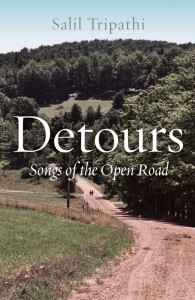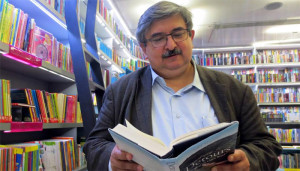Chitra Bannerjee Divakurni, “Before We Visit the Goddess”
Earlier this week I interviewed Chitra Bannerjee Divakurni via email about her latest novel, Before We Visit the Goddess, published by Simon & Schuster. The review-cum-interview article has been published by newly launched literary website, Bookwitty.com on 20 May 2016. Here is the original url: https://www.bookwitty.com/text/573df5efacd0d0353bea32f7 . I am c&p the text below. One of the things I did not point out in the review but continues to bewilder me is the use of a Rajasthani woman on the book cover when all the books by the author focus on Bengali women.
One day, in the kitchen at the back of the store, I held in my hand a new recipe I had perfected, the sweet I would go on to name after my dead mother. I took a bite of the conch-shaped dessert, the palest, most elegant mango color. The smooth, creamy flavor of fruit and milk, sugar and saffron mingled and melted on my tongue. Satisfaction overwhelmed me. This was something I had achieved myself, without having to depend on anyone. No one could take it away…
Chitra Banerjee Divakaruni occupies a capital place in global publishing as is evident in her moves between publishers from Picador to Penguin Random House and now to Simon & Schuster. She may be of Indian origin and her stories are very Bengali oriented but they have far greater international appeal. She moved to the USA in the 1970s but remains culturally sensitive to Bengali women’s stories. For years now she has worked with women’s organizations that help survivors of domestic abuse and trafficking. As she told me, “I am on the advisory board of Maitri in the San Francisco area and Daya in Houston. Maybe for this reason, it is important for me to write about strong women who go through difficult situations and are strengthened further by them. This is certainly true of my newest book, Before We Visit the Goddess. I never use the stories I come across in my activist work – those are confidential. But I am sure on some level they have influenced me as a writer and a human being.”
Her early works focused on the known world of Bengali women in the villages and cities, interpersonal relationships, on the home, inside the kitchen, women to women, and the importance of gossip. One such work, Mistress of Spices (1997) was turned into a film in 2005 with noted Bollywood actress and former Miss World, Aishwarya Rai Bachchan.
A decade later, the path breaking The Palace of Illusions ( 2008) was published. It is a feminist retelling of the ancient Indian epic the Mahabharata from the point of view of the King of Panchala’s daughter. It was a bestseller and according to Pan Macmillan India, now years after publication it continues to sell steadily at around 15,000 copies every year. This was a watershed moment in Chitra Divakaruni Banerjee’s life as a writer. The Palace of Illusions is now to be made into a film directed by the legendary Aparna Sen, which Divakaruni says she is very excited about. She also began to write young adult fiction such as Brotherhood of the Conch series (2003), in reaction, she told me at the time, to racist abuse she experienced with her sons in the US post 9/11.
She quickly returned to writing her trademark literature. Her later novels are written with a stronger voice and with an assertion of her multi-cultural makeup. As she says, “I have many identities, but ultimately labels are just that – labels. My sensibility as a writer has been shaped by living in India and America, Bengal and Assam and California and Texas. … I would like to think of myself as a global, multicultural writer with roots deep in India – and now Houston.”
She writes with great sensitivity to youth especially immigrants coming to the US. The confusion they face, the hostility, the racism, negotiating their way through life but also the unexpected benevolence of humankind that exists.
Before We Visit the Goddess is Divakaruni’s latest novel and sixteenth publication. In the fashionable mold of contemporary fiction with a five-generation saga, it predominantly details the lives of the second, third and fourth generation of women, Bela, Sabitri and Tara. But there is always much, much more tucked into the stories about the grandmother, mother and daughter. A strong characteristic of Divakaruni’s novels is the exploration of relationships between women, the inter-generational gap, the challenges and victories woman experience and the cultural differences of living in India and the US.
“My sensibility as a writer has been shaped by living in India and America, Bengal and Assam and California and Texas.”
To her credit, Divakaruni creates charmingly and deceptively simple women-centric novels. She never presents a utopian scenario focusing only on women and excluding any engagement with men and society. Instead she details the daily negotiations and choices women face that slowly help them develop into strong personalities:
“I believe in the right of women to live a life of dignity and make their own choices about important decisions in their lives. Therefore, I believe in women’s education, empowerment, and financial independence. These themes are all very important in Before We Visit the Goddess.”
It could be, for instance, the timid homemaker Bela’s insistence on taking her late husband’s firm to court to seek compensation for his death in a factory fire and to everyone’s surprise, winning, or Sabitri’s warm friendship with her gay neighbor, Kenneth, who helps her to establish herself successfully as a food blogger. Without being over-sentimental, Kenneth is tender and radiates pure love.
Divakaruni wrote about her character, “The young gay Caucasian male, Ken, became one of my favorite characters as I was writing him. I hope his unusual relationship with Bela will surprise and delight readers.”
Even the bright Tara who, besides a stray phone call or two, disappears from her family’s life after her parents’ divorce lives an adventurous decade. This includes working at a second-hand shop, becoming a drug addict, being sacked from jobs, babysitting an Indian grandmother transplanted to America who feels as if she is “being buried alive”, or driving an Indian academic to a temple in Texas with equally catastrophic and cathartic consequences. What is admirable about these women is that despite humiliation and hardship, they strive to get ahead.
The stories also work beautifully if read aloud. To my delight, I discovered that Divakaruni does just that with passages from her stories while drafting them, since “you become aware of the rhythm of the language you use”.
The structure of her prose is like a fluid stream of consciousness, evident in the manner in which she plays with the epistolary form and breaks it up in the first chapter when Sabitri is writing a letter to her granddaughter, Tara. Divakaruni believes that with women, “our thought-connections are often emotional ones.”
It is exactly this emotional resonance she wishes to explore and exploit in Before We meet the Goddess, deeming it a “novel-in-stories”. It is “a form that allows me to go through three generations of lives, their ups and downs, in an agile and swift manner, a non-chronological manner. This is important for me, because in some ways this is a novel about memory and how it colors and shapes our understanding of our life. Each chapter in the novel is a stand-alone story, focusing on a moment in the lives of these women, an emotionally significant moment, perhaps a moment of transformation – either good or bad. The stories have many narrators – not just the three women, but the man important in their lives – even if just for one day. Such a structure allows me to organize the novel according to emotional resonance.”

In Before We Visit the Goddess the author takes the different phases of life in her stride without making any of the experiences sentimental, such as young Bela’s pain, or the loneliness, and whimsical and wretched behavior of Leelamoyi, Bela’s wealthy benefactress. Her trademark fiction of the world of Bengali women remains steadfast but she also develops the inter-generational differences magnificently. She did her research, she said, by conversing with young Indians including those who have moved to or are studying in the US, and speaks via Skype to classes in colleges that teach her books. She is active on social media and “loves interacting with her readers”.
At a time when debate rages in the US as to whether the word “India” should be replaced with “South Asia” in school history textbooks, Divakaruni’s novel is more than auspicious. According to The New York Times, “The dispute centers on whether the region that includes modern-day India, Pakistan and Nepal should be referred to as India or as South Asia, to represent the plurality of cultures there — particularly because India was not a nation-state until 1947. It also touches on how the culture of the region is portrayed, including women’s role in society and the vestiges of the caste system. It might seem somewhat arcane. But it has prompted petition drives, as well as a #DontEraseIndia social media campaign and a battle of opinion pieces.
Divakaruni’s books have always elegantly examined multi-cultural identities and what it means to be an Indian, an American or a desi (people from the Indian sub-continent or South Asia who live abroad). In her masterfully crafted Before We Visit the Goddess, young Tara epitomizes the new generation of American-Indians — not ABCD (American Born Confused Desis) anymore but with a distinct identity of their own. As a diplomat told me recently, she may be of Indian origin but has no roots or family in the country and has not had any for generations. So a posting to India is as much of an exciting new adventure as it would be for anyone else visiting the country for the first time. Divakaruni’s latest novel examines these many layers of cultures, interweaving the traditional and contemporary.
Chitra Bannerjee Divakurni Before We Visit the Goddess Simon & Schuster, London, 2016. Hb. Pp. 210. Rs 499 / £ 16.99
20 May 2016




